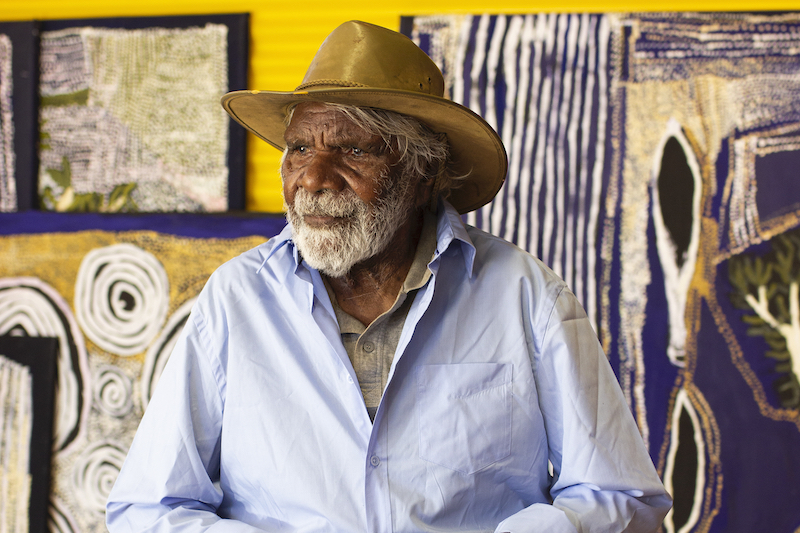Mick Wikilyiri: Every Part Of Me
Mick Wikilyiri’s dynamic paintings are a deeply personal representation of Country, spirituality and family history.
Words: Micheal Do
Tjukurpa as used by Wikilyiri and the Pitjantjatjara people refers to the law and traditions sacred sites and knowledge of Country that encompass their world view. In this context, the Aboriginal use of Country refers to an understanding that landscapes live and breathe. Country knows. Country hears. Country smells. Country speaks. And while there is no single canonical treatment of the Dreaming, artists working at different Art Centres tend to have certain qualities in composition, narrative and style that culminate in a house style. Wikilyiri’s Tjala Arts embraces different mediums – from canvas, to punu (wood and bark paintings) and tjanpi (fibre weaving). Most critical to the house style is the Art Centre’s modus operandi: that its artists work in an experimental environment where they are empowered to develop ideas.
In his forthcoming exhibition at Melbourne’s Alcaston Gallery, Wikilyiri has been working on a range of paintings remark- ably expressive and formally inventive, amalgamating the different permutations and nuances of the Honey Ant Dreaming. When asked about these paintings, Wikilyiri points out that the works stand as maps, biographies and histories. “I may be a Tjilpie, but I know my law,I am strong in my law and I work every day, in the Art Centre, in my community and Country to make sure that law is held and kept strong.
This is the most important thing that I think about. I think this is the most important thing to all Tjilpies like me.” It is this unique perspective that has been recognised in several exhibitions and prizes. This year Wikilyiri is a finalist in this year’s National Aboriginal and Torres Strait Islander Art Awards, one of Australia’s oldest and most prestigious accolades.
In this way, Wikilyiri’s practice bears witness to his innermost worldviews, referencing his familial archive, Dreaming stories, his sense of duty and obligation to his community and Country. It is this interrogation into these aspects that provides audiences with an irreplaceable way of seeing the world — a humbling and energising experience that must be seen to be believed.
BEVERLY KNIGHT
Director, Alcaston Gallery, Melbourne
“I first encountered Mick Wikilyiri at Amata in the APY Lands of South Australia in 1999. I had been assisting the women to set up their Art Centre (then named Minymaku Arts) and before long the senior men were keen to join in. Mick was part of the first men’s painting workshops in 2003. At first, I was won over by his gentle yet charismatic personality. But I was also astounded by his remarkable talent as an artist.
“In 2005 Mick was part of our first group men’s exhibition at Alcaston gallery, Amatala watiku tjukurpa wiru – Good stories from Amata men. He had his first solo exhibition at the gallery in 2014 and then again in 2018 and 2019. I am continually drawn to his unique portrayal of Country in the APY Lands – his landscapes are thoughtfully depicted through striking imagery, stylistic experimentation and intense colour. Mick’s paintings are a highly personal representation of Country, spirituality and a rich family history – a true celebration of his Anangu culture.
“Appreciated by a wide audience, ranging from emerging to established collectors, Mick’s work can be found in major collections across Australia and overseas. His paintings particularly appeal to an international art market, as the colourful compositions give an insight into his deeply sacred Indigenous culture.
“Having represented Mick for close to 15 years, I am perpetually in awe of his artistic achievements, and my support continues with his forth- coming exhibition this September at Alcaston Gallery.”
LUKE SCHOLES
Curator of Aboriginal Art, Museum and Gallery of the Northern Territory, Darwin
“Inspired by designs that appear as rock paintings or petroglyphs on his Country, Wikilyiri creates dramatic constellations of spidery roundels with the occasional presence of ancestral snakes and honey ants. His love of deep, saturated colour, whether it be in blues and purples, reds and yellows, channels a rare intensity.
“Recent works of kulata (spears) high- light his gifted sense of composition. I love his tendency not to fill the entire available space. It provides an endless continuum for each painting to work within. His collaborations with his wife Paniny Mick reveal a unique compatibility. He is a gifted artist, but each work appears hard- won and therefore bristles with integrity.”
This article was originally published in Art Collector issue 89, JUL – SEP, 2019.











